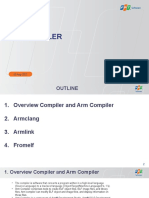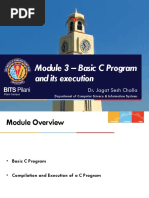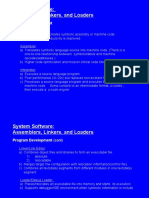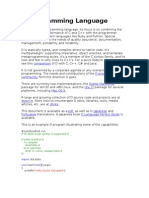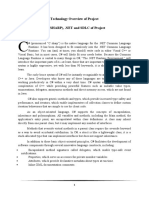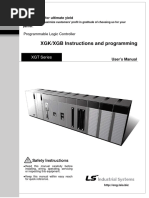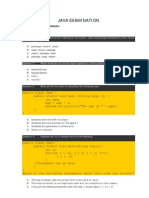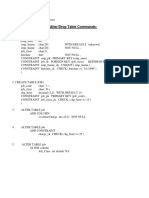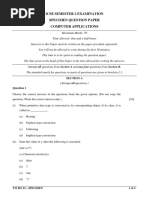Introduction To Cortex-M3 Programming: ARM University Program
Introduction To Cortex-M3 Programming: ARM University Program
Uploaded by
lola ittaCopyright:
Available Formats
Introduction To Cortex-M3 Programming: ARM University Program
Introduction To Cortex-M3 Programming: ARM University Program
Uploaded by
lola ittaOriginal Title
Copyright
Available Formats
Share this document
Did you find this document useful?
Is this content inappropriate?
Copyright:
Available Formats
Introduction To Cortex-M3 Programming: ARM University Program
Introduction To Cortex-M3 Programming: ARM University Program
Uploaded by
lola ittaCopyright:
Available Formats
Introduction to Cortex-M3
Programming
ARM University Program
Copyright © ARM Ltd 2013 1
Module Syllabus
Program Code
C Language vs. Assembly Language
Program-Generation Flow
Cortex-M3 Program Image
Program Data
How is Data Stored in RAM
Data Types
Accessing Data using C and Assembly
Mixed Assembly and C Programming
Calling a C Function from Assembly
Calling an Assembly Function from C
Embedded Assembly
ARM University Program
Copyright © ARM Ltd 2013 2
Program Code
ARM University Program
Copyright © ARM Ltd 2013 3
Program Code Overview
All microcontrollers need a program code to perform an intended task
The program of embedded systems is usually developed at a relatively
lower level
Less supports from operating systems
lack of standard programing interface
Often hardware specific, e.g. memory usage constraints, available instructions etc.
Programming language
Embedded systems are usually programed using C (or C++) language and assembly
language
ARM-based tools can compile the C code or the assembly code to the executable file,
which can be executed by ARM-based processors
A completely integrated program code can be also referred as a program image or an
executable file
ARM University Program
Copyright © ARM Ltd 2013 4
C Language vs. Assembly Language
Language Advantages Disadvantage
Easy to learn Limited or no direct access to core
registers and stack
Portable No direct control over instruction
C sequence generation
Easy handling of complex data No direct control over stack usage
structures
Allow direct control to each Take longer time to learn
instruction step and all memory
Assembly Allows direct access to instructions Difficult to manage data structure
that cannot be generated with C
Less portable
ARM University Program
Copyright © ARM Ltd 2013 5
Typical Program-Generation Flow
The generation of program follows a typical development flow
Compile Assemble Link Download
The generated executable file (or program image) is stored in the program memory
(normally an on-chip flash memory), to be fetched by the processor
Off-line Compilation
C Code
Compile Processor
Assembly Code Fetch
Instructio
Assemble
n Decode
Object Code Libraries Fetch
Link Execute
Program Image
Download Data Input Data Output
Processing
Program Memory
Typical program-generation flow
ARM University Program
Copyright © ARM Ltd 2013 6
Compilation using ARM-based Tools
C, C++
C/
C/C/
C/ C++
C++
C++
C++ C/
C/
C/ C++
C/C++
C++
C++
C/
C/ C++
C++ Assembly
Assembly ASM files
Compile/ assemble
armcc
armcc armasm
armasm
.O Files
C/
C/
C/ C++
C/C++
C++
C++ C/
C/
C/ C++
C/C++
C++
C++
Object
Object Libraries
Libraries .S Files
Link
armlink
armlink &
&
armmar
armmar
.AXF File
Image
Image .LIB file
executable
.BIN File
binary
binary .HEX File
Disassembly File
ARM University Program
Copyright © ARM Ltd 2013 7
Compiler Stages
Parser
Reads in C code,
Checks for syntax errors,
Forms intermediate code (tree representation)
High-Level Optimizer
Modifies intermediate code (processor-independent)
Code Generator
Creates assembly code step-by-step from each node of the intermediate code
Allocates variable uses to registers
Low-Level Optimizer
Modifies assembly code (parts are processor-specific)
Assembler
Creates object code (machine code)
Linker/Loader
Creates executable image from object file
ARM University Program
Copyright © ARM Ltd 2013 8
Cortex-M3 Program Image
What is a program image
The program image (or sometimes referred as executable file) usually refers
to a piece of fully integrated code that is ready to execute
In Cortex-M3, the program image includes:
Vector table – includes the starting addresses of exceptions (vectors) and the
value of the main stack point (MSP)
C start-up routine
Program code – application code and data
C library code – program codes for C library functions
ARM University Program
Copyright © ARM Ltd 2013 9
Cortex-M3 Program Image
Code region
External Interrupts
0x00000040
SysTick 0x0000003C
PendSV 0x00000038
Reserved 0x00000034
Start-up routine & Debug monitor 0x00000030
Program code & SVCall 0x0000002C
C library code
Program Reserved 0x0000001C
Image Usage fault 0x00000018
Bus fault 0x00000014
MemManage fault 0x00000010
Hard fault vector 0x0000000C
NMI vector 0x00000008
Vector table Reset vector 0x00000004
Initial MSP value 0x00000000
Address
ARM University Program
Copyright © ARM Ltd 2013 10
Cortex-M3 Program Image
Vector table
Contains the starting addresses of exceptions (vectors) and the value of the
main stack point (MSP)
Can be programed in either C or assembly
C Start-up code
Used to set up data memory and the initialization values for global data
variables
Is inserted by compiler/ linker automatically, labelled as “__main” by ARM
compiler, or “_start” by GNU C compiler
ARM University Program
Copyright © ARM Ltd 2013 11
Cortex-M3 Program Image
Program code
Program code refers the instructions generated from your application program. The
type of data in the program code includes:
Initial values of variables – the local variables that initialized in functions or
subroutines during program execution time
Constants – used in data values, address of peripherals, character strings, etc…
Sometimes are stored together in data blocks called literal pools
Additionally, constant data such as lookup tables, graphics image data (e.g.
bit map) can also be merged into the program images
C library code
Object codes that inserted to the program image by the linkers
ARM University Program
Copyright © ARM Ltd 2013 12
Program Image in Global Memory
The program image is stored in the code region in the global memory
Up to 512 MB memory space range from 0x00000000 to 0x1FFFFFFF
Usually implemented on non-volatile memory, such as on-chip FLASH
memory
Normally separated from program data, which is allocated in the SRAM
region (or data region)
External RAM
Peripherals
Mainly used for data memory 0x3FFFFFFF
e.g. on-chip SRAM, SDRAM SRAM Region 512MB
0x20000000
0x1FFFFFFF
Mainly used for program image Code Region 512MB
0x00000000
e.g. on-chip FLASH
Global memory space
ARM University Program
Copyright © ARM Ltd 2013 13
Program Data
ARM University Program
Copyright © ARM Ltd 2013 14
How is Data Stored in RAM
Typically, the data can be divided in
three sections: static data, stack, and High
heap:
Grow
Stack Downwards
Static data – contains global variables
and static variables
Stack – contains the temporary data for Memory
Address
local variables, parameter passing in
function calls, registers saving during Grow
Heap
exceptions, etc. Upwards
Heap – contains the pieces of memory Static
spaces that dynamically reserved by Data
function calls, such as “alloc()”,
Low
“malloc()”
ARM University Program
Copyright © ARM Ltd 2013 15
Define Stack and Heap
The stack and heap can be defined in either C language (with
linker file) or assembly language, for example in C:
/*
/* Set
Set stack
stack and
and heap
heap parameters
parameters */
*/
#define
#define STACK_BASE
STACK_BASE 0x10020000
0x10020000 //
// stack
stack start
start address
address
#define
#define STACK_SIZE
STACK_SIZE 0x5000
0x5000 //
// length
length of
of the
the stack
stack
#define
#define HEAP_BASE
HEAP_BASE 0x10001000
0x10001000 //
// heap
heap starts
starts address
address
#define
#define HEAP_SIZE
HEAP_SIZE 0x10000 – 0x6000
0x10000 – 0x6000 // heap length
// heap length
/*
/* inker
inker generated
generated stack
stack base
base addresses
addresses */
*/
extern
extern unsigned
unsigned int
int Image$$ARM_LIB_STACK$$ZI$$Limit
Image$$ARM_LIB_STACK$$ZI$$Limit
extern
extern unsigned
unsigned int
int Image$$ARM_LIB_STACKHEAP$$ZI$$Limit
Image$$ARM_LIB_STACKHEAP$$ZI$$Limit
……
ARM University Program
Copyright © ARM Ltd 2013 16
Define Stack and Heap
Define stack and heap in assembly language:
Stack_Size
Stack_Size EQU
EQU 0x00000400
0x00000400 ;; 256KB
256KB of
of STACK
STACK
AREA
AREA STACK,
STACK, NOINIT,
NOINIT, READWRITE,
READWRITE, ALIGN=4
ALIGN=4
Stack_Mem
Stack_Mem SPACE
SPACE Stack_Size
Stack_Size
__initial_sp
__initial_sp
Heap_Size
Heap_Size EQU
EQU 0x00000400
0x00000400 ;; 1MB
1MB of
of HEAP
HEAP
AREA
AREA HEAP,
HEAP, NOINIT,
NOINIT, READWRITE,
READWRITE, ALIGN=4
ALIGN=4
__heap_base
__heap_base
Heap_Mem
Heap_Mem SPACE
SPACE Heap_Size
Heap_Size
__heap_limit
__heap_limit
ARM University Program
Copyright © ARM Ltd 2013 17
Data Types
A number of standard data types are supported by the C
language
However, their implementation is depending on the processor
architecture and C compiler
In ARM programming, the data size is referred as byte, half
word, word, and double word:
Byte: 8-bit;
Half word: 16-bit;
Word: 32-bit
Double word: 64-bit
The following table shows the implementation of different
data types
ARM University Program
Copyright © ARM Ltd 2013 18
Data Types
Data type Size Signed range Unsigned range
char, int8_t, uint8_t Byte -128 to 127 0 to 255
short, int16_t, uint16_t Half word -32768 to 32767 0 to 65535
int, int32_t, uint32_t, Word -2147483648 to 0 to 4294967295
long 2147483647
long long, int64_t, Double word -263 to 263-1 0 to 264-1
uint64_t
float Word -3.4028234 × 1038 to 3.4028234 × 1038
double, long double Double word -1.7976931348623157 ×10308 to
1.7976931348623157 ×10308
pointers Word 0x00 to 0xFFFFFFFF
enum Byte/ half word/ word Smallest possible data type
bool (C++), _bool(C) Byte True or false
wchar_t Half word 0 to 65535
ARM University Program
Copyright © ARM Ltd 2013 19
Data Types and Class Qualifiers
Const
Never written by program, can be put in ROM to save RAM
Volatile
Can be changed outside of normal program flow: ISR, hardware
register
Compiler must be careful with optimizations
Static
Declared within function, retains value between function invocations
Scope is limited to function
ARM University Program
Copyright © ARM Ltd 2013 20
Example of Data Storage
Zero-Initialized int a, b; Constant data
static data const char c=123;
int d=31;
Initialization Data
Initialized static void main(void) {
data int i;
char f[32]; Startup Code
int *array;
Stack data
array =(int *)malloc(128); Program code
e = d + 7; .text
printf(“Hello!”);
Heap data Runtime Library
} Code
Usually stored in volatile Usually stored in non-volatile
memories, e.g. SRAM memories, e.g. FLASH
ARM University Program
Copyright © ARM Ltd 2013 21
Define Interrupt Vector in C
The interrupt vector can be defined in either C language or assembly
language, for example in C:
typedef
typedef void(*
void(* const
const ExecFuncPtr)(void)
ExecFuncPtr)(void) __irq;
__irq;
#pragma
#pragma arm
arm section
section rodata="exceptions_area”
rodata="exceptions_area”
ExecFuncPtr
ExecFuncPtr exception_table[]
exception_table[] == {{
(ExecFuncPtr)&Image$$ARM_LIB_STACK$$ZI$$Limit,
(ExecFuncPtr)&Image$$ARM_LIB_STACK$$ZI$$Limit, /* /* Initial
Initial SP
SP */
*/
(ExecFuncPtr)__main,
(ExecFuncPtr)__main, /*
/* Initial
Initial PC
PC */
*/
NMIException,
NMIException,
HardFaultException,
HardFaultException,
MemManageException,
MemManageException,
BusFaultException,
BusFaultException,
UsageFaultException,
UsageFaultException,
0,
0, 0,
0, 0,
0, 0,
0, /*
/* Reserved
Reserved */
*/
SVCHandler,
SVCHandler,
DebugMonitor,
DebugMonitor,
0,
0, /*
/* Reserved
Reserved */
*/
PendSVC,
PendSVC,
SysTickHandler
SysTickHandler
/*
/* Configurable
Configurable interrupts
interrupts start
start here...*/
here...*/
};
};
#pragma
#pragma arm
arm section
section
ARM University Program
Copyright © ARM Ltd 2013 22
Accessing Peripherals in C
Define base addresses for peripherals, e.g.
#define
#define FLASH_BASE
FLASH_BASE *((volatile
*((volatile unsigned
unsigned long
long *)
*) (0x00000000UL)
(0x00000000UL)
#define
#define RAM_BASE
RAM_BASE *((volatile
*((volatile unsigned
unsigned long
long *)
*) (0x10000000UL)
(0x10000000UL)
#define
#define GPIO_BASE
GPIO_BASE *((volatile
*((volatile unsigned
unsigned long
long *)
*) (0x2009C000UL)
(0x2009C000UL)
#define
#define APB0_BASE
APB0_BASE *((volatile
*((volatile unsigned
unsigned long
long *)
*) (0x40000000UL)
(0x40000000UL)
#define
#define AHB_BASE
AHB_BASE *((volatile
*((volatile unsigned
unsigned long
long *)
*) (0x50000000UL)
(0x50000000UL)
#define
#define CM3_BASE
CM3_BASE *((volatile
*((volatile unsigned
unsigned long
long *)
*) (0xE0000000UL)
(0xE0000000UL)
Write a value to a peripheral register, e.g.
//store
//store aa value
value to
to the
the memory
memory
RAM_BASE = 0x3FFFF
RAM_BASE = 0x3FFFF
Read a value from a peripheral register, e.g.
//read
//read aa value
value from
from the
the memory
memory
i=
i= RAM_BASE;
RAM_BASE;
ARM University Program
Copyright © ARM Ltd 2013 23
Use Bit-band Operation in Assembly
For example, in order to set bit[3] in word data in address 0x20000000:
Read-Modify-Write operation
Read the real data address (0x20000000)
Modify the desired bit (retain other bits unchanged)
Write the modified data back
Bit-band operation
Directly set the bit by writing ‘1’ to address 0x2200000C, which is the alias address
of forth bit of the 32-bit data at 0x20000000
;Read-Modify-Write
;Read-Modify-Write Operation
Operation ;Bit-band
;Bit-band Operation
Operation
LDR
LDR R1,
R1, =0x20000000
=0x20000000 ;Setup
;Setup address
address LDR
LDR R1,
R1, =0x2200000C
=0x2200000C ;Setup
;Setup address
address
LDR
LDR R0,
R0, [R1]
[R1] ;Read
;Read MOV
MOV R0,
R0, #1
#1 ;Load data
;Load data
ORR.W
ORR.W R0,
R0, #0x8
#0x8 ;Modify
;Modify bit
bit STR
STR R0,
R0, [R1]
[R1] ;Write
;Write
STR
STR R0,
R0, [R1]
[R1] ;Write back
;Write back
ARM University Program
Copyright © ARM Ltd 2013 24
Use Bit-band Operation in C
The bit-band operation is not natively supported in most C compilers
To make ease use of the bit-band feature, the address and the bit-band
address can be separately declared, for example:
#define
#define RAM_Data1
RAM_Data1 *((volatile
*((volatile unsigned
unsigned long
long *)(0x20000000))
*)(0x20000000))
#define
#define RAM_Data1_Bit0
RAM_Data1_Bit0 *((volatile
*((volatile unsigned
unsigned long
long *)(0x22000000))
*)(0x22000000))
#define
#define RAM_Data1_Bit1
RAM_Data1_Bit1 *((volatile
*((volatile unsigned
unsigned long
long *)(0x22000004))
*)(0x22000004))
RAM_Data1=
RAM_Data1= RAM_Data1
RAM_Data1 || 0x01
0x01 ;Setup
;Setup bit0
bit0 without
without using
using bitband
bitband
RAM_Data1_Bit0=
RAM_Data1_Bit0= 0x00
0x00 ;clear
;clear bit0
bit0 using
using bitband
bitband
RAM_Data1_Bit1=
RAM_Data1_Bit1= 0x01
0x01 ;Setup bit1
;Setup bit1 using
using bitband
bitband
Alternatively, use C macros to easily access bit-band alias, for example:
#define
#define RAM_Data1
RAM_Data1 *((volatile
*((volatile unsigned
unsigned long
long *)(0x20000000))
*)(0x20000000))
#define
#define BitBand(data_addr,
BitBand(data_addr, bit)
bit) ((data_addr
((data_addr && 0x0F0000000)
0x0F0000000) ++ 0x2000000
0x2000000 ++
((data_addr
((data_addr && 0xFFFFF)<<5)+(bit<<2))
0xFFFFF)<<5)+(bit<<2))
#define
#define Data_Addr (data_addr)
Data_Addr (data_addr) *((volatile
*((volatile unsigned
unsigned long*)(data_addr))
long*)(data_addr))
Data_Addr(BitBand(RAM_Data1,0))
Data_Addr(BitBand(RAM_Data1,0)) == 0x01
0x01 ;set
;set bit0
bit0
ARM University Program
Copyright © ARM Ltd 2013 25
Mixed Assembly and
C Programming
ARM University Program
Copyright © ARM Ltd 2013 26
Calling a C Function from Assembly
When a C function is called from an assembly file, the
following areas should be aware:
Register R0, R1, R2, R3, R12, and LR could be changed, hence it is
better to save them to the stack
The value of SP should be aligned to a double-word address
boundary
Input parameters have to be stored in the correct registers, for
example, registers R0 to R3 can be used for passing four parameters
The return value is usually stored in R0
ARM University Program
Copyright © ARM Ltd 2013 27
Calling a C Function from Assembly
For example, write an adding function in C:
int
int my_add(int
my_add(int x1,
x1, int
int x2,
x2, int
int x3,
x3, int
int x4)
x4) {{
return
return (x1+x2+x3+x4);
(x1+x2+x3+x4);
}}
Call the C function from the assembly code, for example:
MOVS
MOVSR0,
R0, #0X1
#0X1 ;; parameter
parameter x1
x1
MOVS
MOVSR1,
R1, #0X3
#0X3 ;; parameter
parameter x2
x2
MOVS
MOVSR2,
R2, #0X5
#0X5 ;; parameter
parameter x3
x3
MOVS
MOVSR3,
R3, #0X7
#0X7 ;; parameter
parameter x4
x4
IMPORT
IMPORT my_add
my_add
BL my_add
BL my_add ;; call
call “my_add”
“my_add” function
function in
in CC
ARM University Program
Copyright © ARM Ltd 2013 28
Calling an Assembly Function from C
When calling an assembly function from C code, following
areas should be aware:
If registers R4 to R11 need to be changed, they have to be stacked
and restored in the assembly function
If another function is called inside the assembly function, LR register
needs to be saved on the stack and used for return
The function return value is normally stored in R0
ARM University Program
Copyright © ARM Ltd 2013 29
Calling an Assembly Function from C
Write a function in assembly, for example:
EXPORT
EXPORT add_asm
add_asm
add_asm
add_asm FUNCTION
FUNCTION
ADDS
ADDSR0,
R0, R0,
R0, R1
R1
ADDS
ADDSR0,
R0, R0,
R0, R2
R2
ADDS
ADDSR0,
R0, R0,
R0, R3
R3
BX LR
BX LR ;
; result is
result is returned
returned in
in R0
R0
ENDFUNC
ENDFUNC
Calling an assembly function in C, for example:
external
external int
int add_asm(
add_asm( int
int k1,
k1, int
int k2,
k2, int
int k3,
k3, int
int k4);
k4);
void
void main
main {{
int
int x;
x;
xx == add_asm
add_asm (11,22,33,44);
(11,22,33,44); //
// call
call assembly
assembly function
function
……
}}
ARM University Program
Copyright © ARM Ltd 2013 30
Embedded Assembly
The embedded assembler allows developer to write
assembly functions inside C files, for example in C:
_asm
_asm int
int add_asm(
add_asm( int
int k1,
k1, int
int k2,
k2, int
int k3,
k3, int
int k4)
k4) {{
ADDS
ADDSR0,
R0, R0,
R0, R1
R1
ADDS
ADDSR0,
R0, R0,
R0, R2
R2
ADDS
ADDSR0,
R0, R0,
R0, R3
R3
BX
BX LRLR
}}
void
void main
main {{
int
int x;
x;
xx == add_asm
add_asm (11,22,33,44);
(11,22,33,44); //
// call
call assembly
assembly function
function
……
}}
ARM University Program
Copyright © ARM Ltd 2013 31
Lab Exercise
Lab Exercises
Lab 1 - processing text in assembly language
Execute assembly code on the mbed board (e.g. mbed LPC1768) using
the debugger (in ARM® Keil® MDK )
Examine its execution at the processor level
Lab 2 - square root approximation
Write an assembly code subroutine to approximate the square root of an
argument using the bisection method
Test your result on the mbed board (e.g. mbed LPC1768) using the
debugger (Keil MDK)
mbed LPC 1768
ARM University Program
Copyright © ARM Ltd 2013 32
ARM Keil® MDK
Keil μVision has an Integrated Development Environment (IDE), which allows user to build a
project easily and quickly, the IDE includes:
Project management;
Make facilities;
Source code editing;
Program debugging;
Complete simulation;
A serial of ARM-based tools are
integrated in Keil μVision, including:
Compiler
Assembler
Linker
Format Converter
Libraries
ARM University Program
Copyright © ARM Ltd 2013 33
Useful Resources
Reference1
Book: “The Definitive Guide to the ARM Cortex-M3” by Joseph Yiu, ISBN-10:
0123854776, ISBN-13: 978-1856179638, 12 Jan 2010
Reference2
Cortex-M3 Technical Reference Manual:
http://infocenter.arm.com/help/index.jsp?topic=/com.arm.doc.ddi0337i/index.html
Reference3
Cortex-M3 Devices Generic User Guide:
http://infocenter.arm.com/help/topic/com.arm.doc.dui0552a/DUI0552A_cortex_m3_dgug.p
df
ARM University Program
Copyright © ARM Ltd 2013 34
You might also like
- Backtrader Documentation 1.9.58.122 WJDocument864 pagesBacktrader Documentation 1.9.58.122 WJzr jNo ratings yet
- Lecture 9 Using CDocument28 pagesLecture 9 Using CChandrakant mohadikarNo ratings yet
- Arm Compiler For EmbeddedDocument7 pagesArm Compiler For Embeddedm.k.rameshkumar1No ratings yet
- Intro To CDocument443 pagesIntro To Csandip100% (1)
- Chapter3 CDocument38 pagesChapter3 CsperateNo ratings yet
- Chapter 2.12: Compilation, Assembling, Linking and Program ExecutionDocument43 pagesChapter 2.12: Compilation, Assembling, Linking and Program Executionsi.huynh7302No ratings yet
- Secure Coding in C and C++: of Strings and IntegersDocument3 pagesSecure Coding in C and C++: of Strings and IntegersWilliamsNo ratings yet
- 07 C ProgrammingDocument8 pages07 C ProgrammingSubramanian VenkatesanNo ratings yet
- Tooling Part 2Document55 pagesTooling Part 2abdelrhmandeab20No ratings yet
- CFP Exams DataDocument17 pagesCFP Exams DataZ S PlaysNo ratings yet
- 02 ARM CompilerDocument46 pages02 ARM CompilerAn NgọcNo ratings yet
- Introduction To C ProgrammingDocument36 pagesIntroduction To C ProgrammingMohammed Jeelan100% (1)
- EGR424 S'12 Project #1Document3 pagesEGR424 S'12 Project #1gin1119No ratings yet
- Applied Programming Using C Lec TwoDocument46 pagesApplied Programming Using C Lec TwoAtif KhanNo ratings yet
- Unit 1 Lecture MaterialDocument68 pagesUnit 1 Lecture Materialparvathy.kNo ratings yet
- CH1-IoT IntroductionDocument69 pagesCH1-IoT IntroductionSakshi SonavaneNo ratings yet
- The C Programming Environment in Linux GCC, Make, Makefiles and GDBDocument16 pagesThe C Programming Environment in Linux GCC, Make, Makefiles and GDBLujainNo ratings yet
- Module 3 - Basic C Program Its ExecutionDocument32 pagesModule 3 - Basic C Program Its Executionsasanktumpati60No ratings yet
- Today We'll Talk Generally About C++ Development (Plus A Few Platform Specifics)Document15 pagesToday We'll Talk Generally About C++ Development (Plus A Few Platform Specifics)Azizullah TahzibNo ratings yet
- CDocument164 pagesCASHISHNo ratings yet
- 18BCS23C-U1Document60 pages18BCS23C-U1parweensimran991No ratings yet
- Introduction To Computers - Languages: Department of Computer and Information Science, School of Science, IUPUIDocument16 pagesIntroduction To Computers - Languages: Department of Computer and Information Science, School of Science, IUPUIRaajula AmarnathNo ratings yet
- Module 3 - Basic C Program Its ExecutionDocument19 pagesModule 3 - Basic C Program Its ExecutionKHUSHI GUPTANo ratings yet
- DPCPP CPP Compiler - Get Started Guide - 2024.2 767258 824361Document11 pagesDPCPP CPP Compiler - Get Started Guide - 2024.2 767258 824361ElectroFuzzNo ratings yet
- AES Algorithm C CodesDocument1 pageAES Algorithm C CodeschernweiNo ratings yet
- Lab 2 C Programming On Linux, Mac OS X Course: Operating SystemsDocument13 pagesLab 2 C Programming On Linux, Mac OS X Course: Operating SystemsSao Hỏa SehnsuchtNo ratings yet
- 402v02 RVDS 40 Intro TutorialDocument34 pages402v02 RVDS 40 Intro Tutorialtnath_20051972No ratings yet
- Using ARDocument8 pagesUsing ARmohammedmokhimerNo ratings yet
- Programming On UnixDocument17 pagesProgramming On Unixpolymathswot1No ratings yet
- Lecture No.03Document11 pagesLecture No.03Shabir AhmadNo ratings yet
- C++ ConceptDocument82 pagesC++ ConceptRaju KumarNo ratings yet
- #NOTEs C++Document132 pages#NOTEs C++Gaurav saoNo ratings yet
- System Software: Assemblers, Linkers, and Loaders: Program DevelopmentDocument17 pagesSystem Software: Assemblers, Linkers, and Loaders: Program Developmentshwts12No ratings yet
- Embedded System Diploma Sameh AfifiDocument37 pagesEmbedded System Diploma Sameh AfifiMohamedYounesNo ratings yet
- Bach, John - Learning Java - Beginning Programming With Java For Dummies (2020) PDFDocument138 pagesBach, John - Learning Java - Beginning Programming With Java For Dummies (2020) PDFMmmNo ratings yet
- New D Prog LanguageDocument8 pagesNew D Prog Languagevikalpvs4263No ratings yet
- Introduction To Computers - Languages: Department of Computer Science & Engg. Sgi, SamalkhaDocument16 pagesIntroduction To Computers - Languages: Department of Computer Science & Engg. Sgi, SamalkhaManoj SharmaNo ratings yet
- An Efficient C++ Framework For Cycle-Based Simulation: September 2002Document7 pagesAn Efficient C++ Framework For Cycle-Based Simulation: September 2002prasanna_npNo ratings yet
- RzaikpdfDocument518 pagesRzaikpdfuppersoftchasewellNo ratings yet
- Building and Using A Cross Development Tool ChainDocument10 pagesBuilding and Using A Cross Development Tool Chainbrajesh kumar patroNo ratings yet
- EE403W Senior Project Design Design: Section 4 Embedded Systems Section 4 - Embedded Systems C TutorialDocument42 pagesEE403W Senior Project Design Design: Section 4 Embedded Systems Section 4 - Embedded Systems C Tutorialkingkey100% (1)
- Complete Notes Koe062 FinalDocument152 pagesComplete Notes Koe062 FinalAnsh TyagiNo ratings yet
- Core Java Some Important Points To RememberDocument26 pagesCore Java Some Important Points To Rememberapi-2593060380% (5)
- C TutorialDocument66 pagesC TutorialSatyam KumarNo ratings yet
- C MaterialDocument114 pagesC MaterialKarthiya BanuNo ratings yet
- Full C++Document123 pagesFull C++manigandanNo ratings yet
- An Introduction To GCCDocument6 pagesAn Introduction To GCCVenkataramana__7139No ratings yet
- Unit 5thDocument13 pagesUnit 5thDevika KachhawahaNo ratings yet
- BC - DCOM ConnectorDocument10 pagesBC - DCOM ConnectorRicardo ValeroNo ratings yet
- OOP - C++ Programming Basics-1Document78 pagesOOP - C++ Programming Basics-1Sourin SarkarNo ratings yet
- 05 Compilation Linking LoadingDocument19 pages05 Compilation Linking LoadingAjit PawarNo ratings yet
- C Complete MaterialDocument249 pagesC Complete Material2002svinfotechNo ratings yet
- Learning Java: Beginning programming with java for dummies Bach all chapter instant downloadDocument65 pagesLearning Java: Beginning programming with java for dummies Bach all chapter instant downloadgavennachev100% (3)
- University Health CareDocument43 pagesUniversity Health CareAshish SinghNo ratings yet
- C MaterialDocument47 pagesC MaterialdeeuGirlNo ratings yet
- CPP CPP MSVC 170Document1,237 pagesCPP CPP MSVC 170zhbhatti80No ratings yet
- Finalised Modified Copy of PCD Lab ManualDocument64 pagesFinalised Modified Copy of PCD Lab ManualcsesathyaNo ratings yet
- CSC 212 Assembler Practical 1Document14 pagesCSC 212 Assembler Practical 1Royal GabrielNo ratings yet
- Introduction To C++ ProgrammingDocument36 pagesIntroduction To C++ ProgrammingMd Mozasser RahmanNo ratings yet
- Spark ArchitectureDocument7 pagesSpark ArchitectureKRamakrishnaNo ratings yet
- XGT XGK ManualDocument610 pagesXGT XGK ManualWrya SaeedNo ratings yet
- Functions, Modules and Packages in Python: N.Venkatesh Asst - Prof of CSEDocument18 pagesFunctions, Modules and Packages in Python: N.Venkatesh Asst - Prof of CSEAnkurNo ratings yet
- With Spark SQL: Delta Lake DDL/DML: Time TravelDocument2 pagesWith Spark SQL: Delta Lake DDL/DML: Time TravelddNo ratings yet
- Class 6Document25 pagesClass 6Haneesha MuddasaniNo ratings yet
- Demo ABAP Objects Program: Contributed by Anon. Sunday, 27 May 2007Document4 pagesDemo ABAP Objects Program: Contributed by Anon. Sunday, 27 May 2007mona2009poojaNo ratings yet
- Java Examination (Include Answer)Document14 pagesJava Examination (Include Answer)Duy TrungNo ratings yet
- RTL Logic Synthesis TutorialDocument7 pagesRTL Logic Synthesis TutorialShama LolyNo ratings yet
- Expirement No. 1 Introduction To GNU Octave PDFDocument9 pagesExpirement No. 1 Introduction To GNU Octave PDFDarrel Damo PasaloNo ratings yet
- Object Oriented ProgrammingDocument25 pagesObject Oriented ProgrammingParth R. ShahNo ratings yet
- New Text DocumentDocument4 pagesNew Text DocumentLeftyRPZNo ratings yet
- Lab Answer Key - Module 1 - Introducing Visual Basic and TheDocument31 pagesLab Answer Key - Module 1 - Introducing Visual Basic and TheJoemarco BernabeNo ratings yet
- Answers To SQL Practice QuestionsDocument20 pagesAnswers To SQL Practice Questionsnuwandara abeykoonNo ratings yet
- vbaUK PDFDocument156 pagesvbaUK PDFricardo prezziNo ratings yet
- Name: Sujay Jogdand - ROLL NO:17100BTBDAI01635 - Subject: PPL - Submittd To: Mr. Romil RawatDocument29 pagesName: Sujay Jogdand - ROLL NO:17100BTBDAI01635 - Subject: PPL - Submittd To: Mr. Romil Rawatroopam patilNo ratings yet
- Learn Python The Hard Way Documentation: Release 0.1Document21 pagesLearn Python The Hard Way Documentation: Release 0.1api-25943213No ratings yet
- Dynamic Programming (Dr. Ashraf Iqbal) (WWW - myUET.net - TC)Document154 pagesDynamic Programming (Dr. Ashraf Iqbal) (WWW - myUET.net - TC)Kashif IlyasNo ratings yet
- Practical Lab 3Document7 pagesPractical Lab 3Vishal KumarNo ratings yet
- CNC Machining Process Planning ProductivityDocument8 pagesCNC Machining Process Planning ProductivityJuan RasconNo ratings yet
- ICSE Semester 2 Specimen - 861 CTA1Document4 pagesICSE Semester 2 Specimen - 861 CTA1Constantine ByzantineNo ratings yet
- One View by AKTU SDC TeamDocument2 pagesOne View by AKTU SDC TeamUtkarsh shuklaNo ratings yet
- KPMG Recent Power BI Interview Q&ADocument5 pagesKPMG Recent Power BI Interview Q&Ahappy yadav100% (1)
- BCA 103 Unit2 PPTDocument21 pagesBCA 103 Unit2 PPTKinjal BhattNo ratings yet
- PowerMax and VMAX All Flash - Unisphere Alert 'Back-End Metadata Usage' Value Exceeded Threshold. - Dell USDocument3 pagesPowerMax and VMAX All Flash - Unisphere Alert 'Back-End Metadata Usage' Value Exceeded Threshold. - Dell USPriyank RajNo ratings yet
- 3.4.3 Translation Software (MT)Document9 pages3.4.3 Translation Software (MT)Herman OduorNo ratings yet
- Computer Basic QuestionsDocument12 pagesComputer Basic Questionseslavathmohan0007No ratings yet
- RITIKDocument2 pagesRITIKujjwalNo ratings yet
- REXX Programming: Arsalan-MeenalDocument19 pagesREXX Programming: Arsalan-MeenalKunalNo ratings yet
- JOPStackDocument17 pagesJOPStackMina R WaheebNo ratings yet










